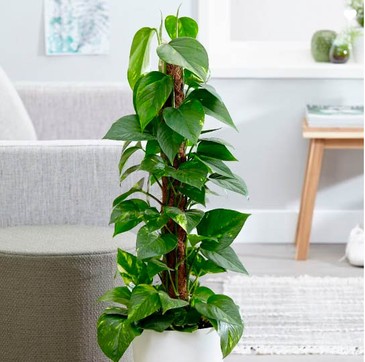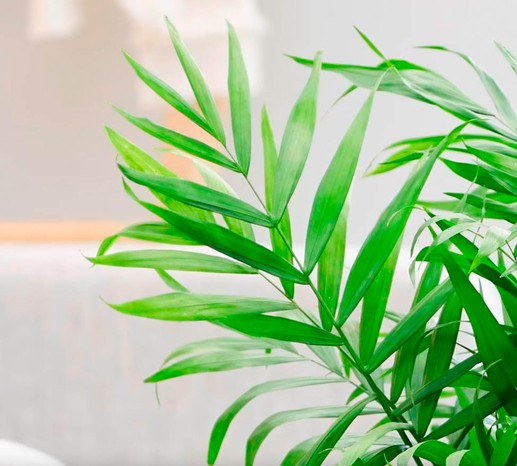
Large indoor plants: 15 of the best
Looking for a big house plant that will make an instant impact in your home? We recommend 15 large house plants that will bring a lush, jungly feel to any space.
A large indoor plant can instantly transform the look and feel of a room, breathing life into the space and making it feel lush, calm and welcoming.
There are many large house plants to choose from, from palms that give a lush feel to plants with large leaves that make a real statement, such as a Swiss cheese plant, rubber plant or bird of paradise.
Advice on choosing a large indoor plant
Before choosing a large indoor plant, assess your space. Do you need to fill a tall, thin spot, or do you need to fill a larger empty area?
Think carefully about light. Most house plants do best a few feet from a window. Larger leaved plants are adapted to coping with lower light levels, but bear in mind that any plant will struggle in a dark corner. Some plants, such as the fiddle leaf fig, do not like to be moved around, so choose its permanent spot carefully.
Make sure you've checked how fast your chosen plant grows, and its ultimate height and spread. For instant impact, buy the biggest plant you can afford.
Once you've chosen your plant, you'll need to find the right pot to complement it. Read our feature on the best ceramic plant pots.
How to water large indoor plants
Check the watering needs of your chosen plant. Most need watering when the top few centimetres of compost is dry, but some, such as Euphorbia trigona, can survive on less.
Repotting large indoor plants
The larger your plant pot and the bigger the plant, the harder it can be to repot a plant. If the whole operation is proving too tricky, there is a simple solution. Simply scrape away as much of the compost as you can with a spoon or fork – at least 5cm, taking care not to damage the roots – and replace it with fresh. You can do this every year, in spring.
The best trailing house plants

Large indoor plants: the best to grow
Swiss cheese plant, Monstera deliciosa

If it's big leaves you're after, they don't come much bigger than those of a Swiss cheese plant (Monstera deliciosa). This Seventies classic is back in fashion again, and has much to offer, with its dramatic and glossy and holey leaves. A variegated variety, Monstera deliciosa 'Variegata', is also available. A Swiss cheese plant will sprawl, so is best grown up a mossy pole. After a while, many people find that their plant outgrows their space (in the wild it can reach 25m tall, and will ultimately reach around 8m in a house), and pass it on. But in the meantime it has a lot to offer, and is usually problem free.
Ultimate height and spread: 8m x 2.5m
Best for: big leaves and a large space
Bird of paradise, Strelitzia reginae

The bird of paradise plant (Strelitzia reginae) has striking blue-green, paddle-like leaves that bring an exotic look to any space. If the conditions are right, when it reaches around four years old, it will produce a flower that looks like the plumage on the head of an exotic bird. It enjoys humidity, so is ideal for a bathroom. Alternatively, stand on a tray of pebbles or gravel topped up with water.
Ultimate height and spread: 1m x 60cm
Best for: an exotic look, bathroom
Yucca, Yucca elephantipes

Yuccas have a spiky and architectural look that suits a modern, minimalist room or a small space, as they are usually tall and narrow. They're tough and tolerant of neglect, so are a good low maintenance option. Water only very sparingly in winter. Avoid placing the sharp leaves at eye level, as the pointed ends of the leaves are sharp.
More like this
Ultimate height and spread: 1.5m x 75cm
Best for: low maintenance, minimalist look, tight spot
Sago palm, Cycas revoluta

Actually not a palm but a cycad, the sago palm has an uncluttered, architectural look and graceful arching foliage. It is a good low maintenance option as it can cope with some neglect and doesn't need much watering.
Ultimate height and spread: 1.5m x 1.5m
Best for: low maintenance, contemporary look
Fiddle leaf fig, Ficus lyrata

Social media went crazy for the fiddle leaf fig a few years ago, and it remains a popular choice. It's beautiful leaves are said to be the same shape as that of a fiddle. The fiddle leaf fig hails from western Africa, and can be a little temperamental in its needs - it does not appreciate being moved around and prefers temperatures on the warm side – don't let them drop below 12°C, try to keep them consistent and keep away from cold draughts. The fiddle leaf fig also appreciates some humidity, so mist the leaves from time to time or stand on moist pebbles. One for a more experienced house plant owner.
Ultimate height and spread: 1.8m x 1.2m
Best for: unusual leaves, experienced house plant owners
Kentia palm, Howea forsteriana

The Kentia palm has fresh green leaves that fan out from tall stems, bringing a lush look to any room. It's tolerant of lower light levels and is pretty easy to care for, making it a good choice for beginners.
Best for: beginners, an elegant look
Ultimate height and spread: 3m x 2m
African milk tree, Euphorbia trigona

Euphorbia trigona is an unusual succulent that originates from Western Africa. With its upright stems, it makes an architectural statement in a room. It is thorny and has a milky sap, so keep out of the reach of children and pets. It needs a warm, bright spot away from draughts and is drought tolerant for short periods.
Ultimate height and spread: 1.8m x 50cm
Best for: a bright spot, low maintenance
Rubber plant, Ficus elastica

Rubber plants have been popular house plants for decades and new varieties, such as Ficus elastica 'Robusta' have bigger, more dramatic leaves. They are easy to care for – just give them a bright spot out of direct sunlight and water when the top few centimetres of compost are dry. Wipe the leaves from time to time to keep them dust-free and glossy.
Ultimate height and spread: 3m x 75cm
Best for: large leaves, beginners
Sansieveria cylindrica

We're all familiar with the mother-in-law's tongue, Sansevieria trifasciata, but its cousin Sansevieria cylindrica is an interesting choice. It has tall, upright, cylindrical and striped stems that look great in a modern home. It is incredibly low maintenance and tolerant of neglect – sansevierias are hard to kill.
Best for: a tight spot, low maintenance
Ultimate height and spread: 1.2m x 50cm
Devil's ivy, Epipremnum aureum

This climbing (or trailing) house plant has many different names – Scindapsus, pothos or Devil's ivy. It is one of the easiest house plants to grow. It has attractive, heart-shaped leaves and will climb upwards if you provide it with a support such as a mossy pole. Some have variegated or splotched leaves, or golden yellow foliage.
Best for: a tight spot, low maintenance
Ultimate height and spread: 2m x 30cm
Areca palm

The Areca Palm also goes by the name of golden cane palm and yellow palm, thanks to its yellow stems. It is also know as the bamboo palm or butterfly palm. It forms a fountain of delicately arched fronds. Areca palms like humidity, so a bathroom is the perfect spot for them. Alternatively, mist the leaves regularly.
Best for: a lush feel, bathroom
Ultimate height and spread: 1.8m x 75cm
Parlour palm, Chamaedorea elegans

The parlour palm was a familiar sight in Victorian drawing rooms, and it's still popular house plant today thanks to its graceful, arching fronds and elegant look. It likes a bright spot and appreciates some humidity, so mist the leaves regularly.
Ultimate height and spread: 2.5m x 1.5m
Best for: a lush feel, bathroom
Philodendron xanadu

If you want a wide house plant with bold leaves that doesn't get too tall, Philodendron xanadu is the choice for you. It has attractively lobed leaves and red stems, and brings a jungly look to a space. It's pretty low maintenance, too.
Best for: a wide area
Ultimate height and spread: 1m x 1m
Dragon plant, Dracaena marginata

The dragon plant, Dracaena marginata, has strappy foliage that is attractively edged with red and sits on top of tall, thin woody stems. It is a slender plant, so is the perfect choice for a tight spot. A dragon plant can last for years but grows slowly, so if you want instant impact, treat yourself to a larger, established plant. Dragon plants are undemanding and prefer to be underwatered rather than overwatered, so let the top few centimetres of soil dry out before watering again. They are ideal for beginners or house plant owners with little time.
Read our expert guide to growing a dragon plant.
Ultimate height and spread: 2m x 30cm
Best for: a tight spot, beginners
Weeping fig, Ficus benjamina

A weeping fig is a light and airy addition to a room, with gently arching stems of dark green or variegated leaves. It needs the right conditions, otherwise it may drop its leaves – avoid under or overwatering, moving it around or repotting it too often.
Ultimate height and spread: 3.5m x 1.2m
Best for: light and airy look, experienced house plant owners
Authors
Veronica Peerless is a trained horticulturalist and garden designer.

Niwaki bundle worth £57 when you subscribe
Subscribe to Gardens Illustrated magazine and claim your Niwaki bundle worth £57
*UK only

Container Gardening Special Edition
The Gardens Illustrated Guide to Container Gardening.
In this special edition, discover colourful flower combinations and seasonal planting schemes for pots designed by leading plantspeople, and essential know-how for container gardening success. Just £9.99 inc UK p&pBy entering your details, you are agreeing to our terms and conditions and privacy policy. You can unsubscribe at any time.

Gardens of the Globe
From botanical wonders in Australia to tranquil havens closer to home in Ireland, let this guide help you to discover some of the most glorious gardens around the world
By entering your details, you are agreeing to our terms and conditions and privacy policy. You can unsubscribe at any time.




